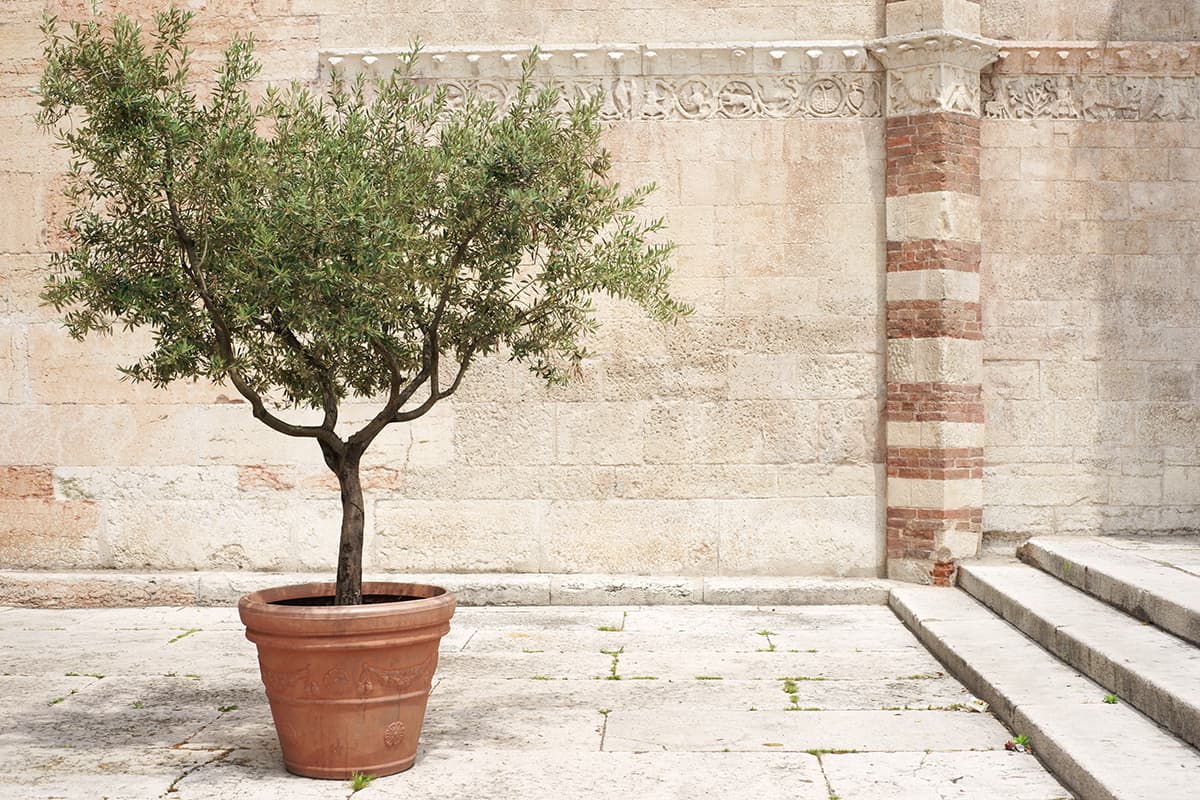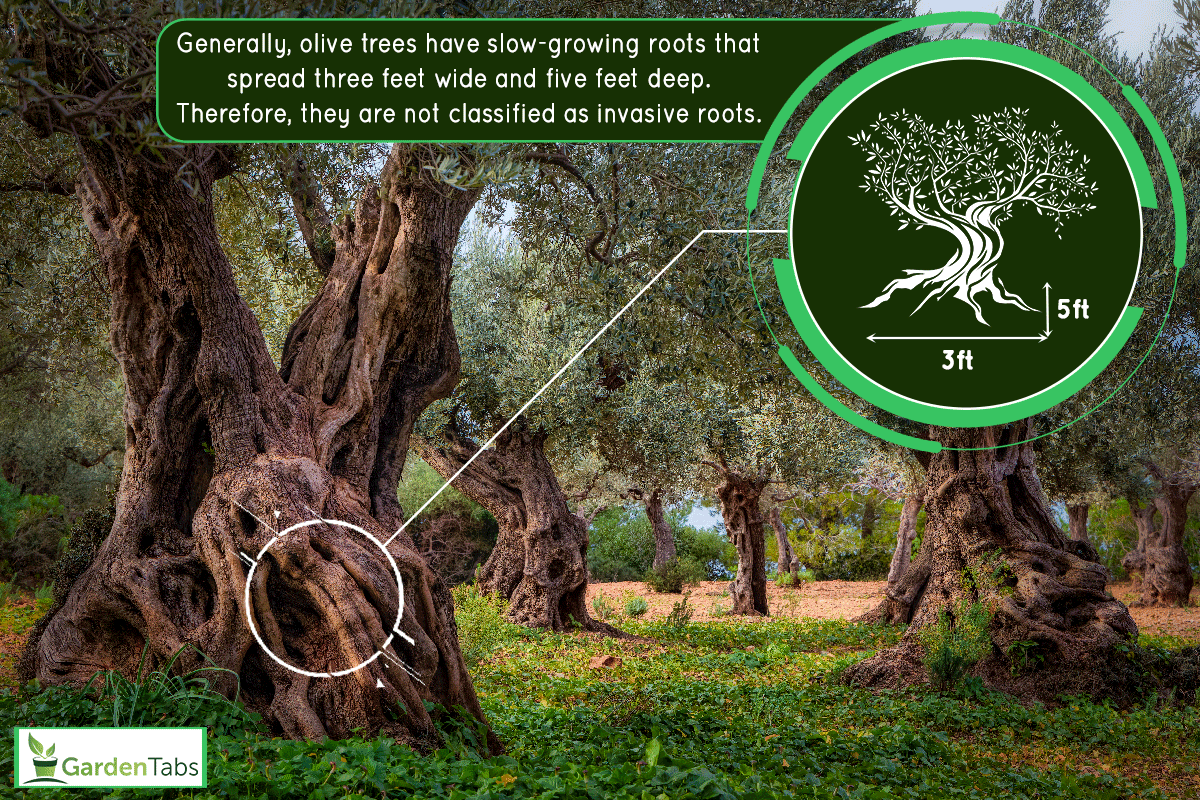Trees rely on their roots for stability and to absorb nutrients and water from the soil. But these roots can be a menace for homeowners when they cause disruptions to patio slabs, pavements, or buildings. So, if you are considering growing olive trees, you may want to find out if they have invasive roots. We did research and have come to this conclusion.
Generally, olive trees have slow-growing roots that spread three feet wide and five feet deep. Therefore, they are not classified as invasive roots.
It is important to note that the roots often extend as wide as the tree's crown. So some olive tree varieties may have roots that grow very wide. Therefore, do your due diligence and only plant olive trees that will not prove destructive to your yard.
Keep reading to equip yourself with more knowledge about olive trees. We will tackle their characteristics, how to care for them, and highlight some benefits.

Characteristics of Olive Trees
The term "olive tree" is commonly used to refer to about 35 species of evergreen shrubs and trees of the Oleaceae botanical family and Olea genus. In particular, the name alludes to Olea europaea, an evergreen tree that bears edible fruits.
Olive trees have a great spiritual significance; they symbolize wisdom, glory, power, fertility, and purity. In addition, they represent strength and intelligence.
These are some of their characteristics.
Vast Root System

Olive trees have a strong tap-root and shallow, wide-spreading roots. The shallow roots are found on the top soil though you can see them above the ground sometimes.
While the tap root is the wellspring of the tree's stability, the shallow roots reinforce its solidity. In addition, the shallow roots absorb most of the moisture for the plant's use. The tap root enables the tree to absorb moisture in drought-like climatic conditions.
The roots of olive trees are slow-growing and spread about three feet wide and five feet deep. Therefore, they are not categorized as invasive roots.
Preventive Measures to Keep Olive Tree Roots From Becoming Invasive
If you grow olive trees as potted plants, you have no cause for concern that the roots will become destructive. But if you decide to plant the trees in your yard, it is prudent to put preventative measures to keep the roots from spreading very wide.
Choose a Suitable Space for the Tree's Size
Considering that the roots of olive trees spread as wide as their canopy, it is advisable to plant them in spaces with sufficient room for the roots to expand as the tree matures.
Plant the trees away from fences, houses, or sewer lines to keep these structures safe. Maintaining a 20 feet of distance between the olive tree and your house is best because some olive trees' roots can spread to about 20 feet at maturity.
The sizes of mature olive trees are pretty diverse. Some trees become gigantic while others remain considerably small.
Therefore, conduct extensive research on the olive tree species you intend to plant to ensure that it is suitable for your yard. The good thing is that you have a vast selection pool.
Trees that do not become too large are ideal for small gardens. These include Arbequina and Nocellara Del Belice olive trees that grow to about 15 feet to 20 feet tall at maturity. Alternatively, you can plant dwarf olive tree species that measure 8 feet to 10 feet tall.
Use Root Barriers
Root barriers re-direct root growth, causing the tree roots to grow downwards instead of sideways. So they allow you to plant olive trees near structures since the tree's roots will not grow horizontally and damage them.
Root barriers made of high-density polyethylene (HDPE), fiberglass, or metal are impermeable. You can spray these barriers with a growth inhibitor to improve their success level.
Some root barriers are made of mesh. Because these barriers are permeable, they do not work as efficiently as the impermeable ones.

See this tree root barrier on Amazon.
Tenacious and Resilient

Olive trees can spring back to life after a fire. The tree's dormant buds increase its regeneration capacity.
If a partial fire scorches the tree, you only need to clean or remove the damaged sections of the trunk and nourish the soil with rich nutrients that the tree can quickly assimilate. The tree then self-heals.
If the fire causes more extensive damage, you may need to cut down the tree and leave a stub just above ground level. Over time, the tree will sprout again from the branches that shoot up from the stump. Prune the new growth over the years to aid the branch in becoming a tree with its trunk.
Olive trees with a well-established root system can survive prolonged droughts and extreme weather conditions. In addition, these trees can withstand various pests and diseases.
While the tree can withstand unfavorable weather, these conditions can adversely affect its yield.
Suppose the plant fails to receive adequate water and nutritional supplies six weeks before flowering. In that case, it can thwart fruit formation since it lacks enough resources to carry on with the flowering process.
Evergreen
The olive tree foliage remains green through the seasons. The leaves are feather-shaped and grow opposite one another along a twig. They are silvery green in color, with a pale underside and dull topside.
The tree sheds and replaces its leaves every two or three years. The shedding and new leaf growth occur simultaneously in the spring.
Changing Growth Patterns
Young olive trees have smooth bark, while the bark of mature trees has high ridges and deep fissures. In addition, the tree grows twisted over time as the trunk's growth pattern changes. Furthermore, the bark in mature trees sheds in thin scale-like plates.
Produce Small Ovular Fruits
Typically, olive trees start bearing fruit after four years. They produce fruits that have thick, meaty-textured flesh and very thin skin.
Often, the fruits are green when unripe and turn blackish-purple when ripe. But some varieties remain green even when ripe, and some become copper-brown when ripe.
Generally, raw olives are unpalatable since they are very bitter. You can make them enjoyable by curing or fermenting them.
How to Care for Olive Trees Indoors
Ideally, it would be best to plant olive trees in the yard. These trees require pollination to produce fruit.
Most varieties require cross-pollination for them to bear good quality fruits. Often, the agents of pollination are insects or the wind, both of which are found in substantial quantities outside.
But some species thrive when self-pollinating. Self-pollination is plausible since olive trees produce male flowers and flowers with male and female characteristics.
The male flower produces pollen, while fertilization occurs in the female parts of the flower. Fruit production occurs after fertilization.
That said, because olive trees are quite adaptable, your tree can still thrive as an indoor plant if you take good care of it. Buying an olive species that can do well indoors increases its chances of survival.
It is important to note that indoor olive trees do not live as long as those grown in the yard. In addition, olive trees grown indoors rarely reach maturity. You can transplant the trees outside when indoor conditions no longer favor healthy development.

Taking good care of your olive trees improves the quality and increases the yield of olives. These pointers will guide you in taking care of your olive tree indoors.
Expose to Adequate Sunlight
Strategically position the olive tree next to a window where it can receive at least six to eight hours of sunlight. Be careful to leave a considerable distance between the tree and window glass; intensified sunlight can burn the leaves.
Water Consistently
Plant olive trees in well-draining soil and water the plant weekly for the first year after planting.
Alternatively, you can use the touch test to determine when you should water the plant to avoid overwatering your olive tree. Water your tree when the top 2 inches of soil feel dry.
Once the tree becomes well established, you can reduce the number of times you water your tree to once a month. When watering the tree monthly, you may need to soak the soil and let the excess water flow through the drainage holes.
Also, allow enough time between watering for the soil to dry.
You can also periodically nourish the soil with a balanced house-plant fertilizer to keep your plant well fed. Add the fertilizer twice a month in spring and summer, then reduce it to once a month in the slow-growing seasons of autumn and winter.
Prune Periodically
Although olive trees are slow growing, they may eventually outgrow their space inside your home. For this reason, it is advisable to prune their tips to maintain them at a manageable size.
Pruning also ensures that the foliage receives sufficient light and air. Thus, your tree maintains a full, bushy shape.
You may also need to repot the plant annually to ensure that the tree has enough room to grow as it expands.
What are the Benefits of Farming Olive Trees?

Olive fruits are pressed to produce olive oil, which is used in many dishes worldwide. In addition, olive fruits contain healthy fats, antioxidants, and fiber. So you can enjoy these fruits as a delicious snack when you treat them.
Olive trees are also a source of highly prized wood. Because of its slow-growing nature, the tree has very close-grained and attractive timber. Olive tree wood is used to make decorative items, woodenware, or fine furniture.
The trees also make beautiful ornamental trees due to their evergreen foliage and attractive spring flowers.
In Conclusion
The most effective way to make sure that olive tree roots do not become invasive is by choosing a suitable tree for your space.
Additionally, leave enough room between your tree and structures such as houses, fences, and pavements to accommodate possible root expansion since the roots spread in proportion to the canopy size.
You may also be interested in these topics:
Why Is My Olive Tree Dying? [And What To Do About It]
11 Evergreen Shrubs With Non Invasive Roots


Please sent me some info on keeping olive trees!
Hi Hannes! Check out these posts:
1. https://gardentabs.com/why-olive-tree-dying-what-to-do/
2. https://gardentabs.com/olive-tree-dead/